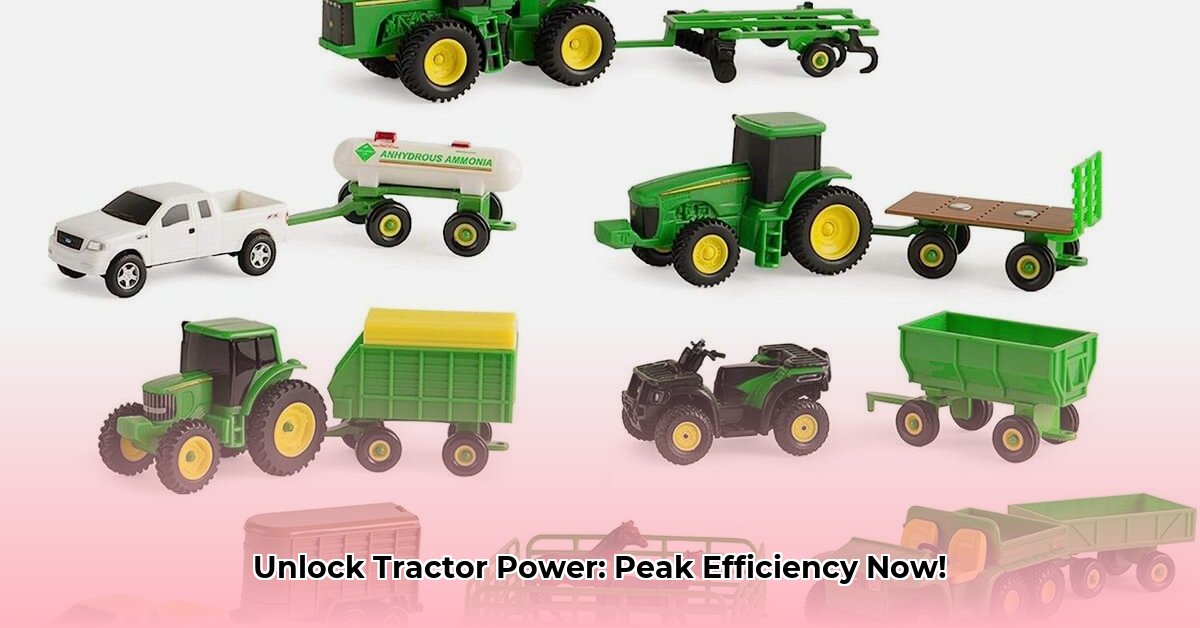
Set Tractor: Unlocking Your Tractor's Full Potential
A properly set-up tractor is the key to maximizing efficiency and minimizing costs. Improper settings lead to wasted fuel, reduced productivity, and potential equipment damage. This section outlines the crucial steps to optimize your tractor's performance. For more in-depth guidance, check out this helpful resource: Tractor Operation Guide.
Understanding Your Tractor's System
Before making any adjustments, familiarize yourself with your tractor's specific features and controls. Consult your owner's manual for detailed diagrams and explanations of the hydraulics, power take-off (PTO), and three-point hitch systems. Understanding your tractor’s unique characteristics is paramount to maximizing its capabilities.
Optimizing Hydraulic System Performance
The hydraulic system is responsible for the smooth operation of implements. Incorrect hydraulic settings result in jerky movements and potential mechanical issues. Adjust pressure and flow according to the specific implement's requirements, ensuring a balance between efficient operation and minimizing wear and tear. "Overly aggressive hydraulic adjustments can lead to premature equipment failure," says Dr. Amelia Hernandez, Agricultural Engineering Professor at the University of California, Davis.
Mastering Three-Point Hitch Alignment
The three-point hitch connects your implements to the tractor. Proper alignment ensures that the implement works correctly, efficiently, and safely. Ensure the implement is level and aligned before operation. Incorrect alignment leads to reduced productivity and potential damage to both the implement and the tractor.
PTO Speed Calibration for Optimal Results
The PTO transfers power from the tractor to implements like mowers and balers. Setting the correct PTO speed is crucial to prevent damage to equipment and achieve peak efficiency. Mismatch between PTO speed and implement requirements can result in diminished output and higher wear-and-tear, shortening the lifespan of your equipment. "Always consult your implement’s manual for specified PTO speed ranges," advises John Miller, Master Mechanic at Miller's Tractor Repair.
Wheel Wellness: Maintaining Proper Tire Pressure
Maintaining the correct tire pressure is critical for traction, fuel efficiency, and tire lifespan. Under-inflation leads to increased fuel consumption and premature wear, while over-inflation compromises traction and causes a rough ride. Refer to your tractor's manual for the recommended tire pressure based on load and terrain. Consistent tire pressure checks are a simple yet effective way to boost your tractor's efficiency and longevity.
Preventative Maintenance: A Long-Term Investment
Regular preventative maintenance is essential for maximizing tractor lifespan and minimizing unexpected breakdowns. This includes regular checks of fluids, filters, and wear-and-tear parts. Proactive maintenance significantly extends the tractor's usable life and minimizes costly repairs. "Preventative maintenance is not just cost-effective; it's essential for safety and sustained productivity," notes Sarah Chen, a leading agricultural consultant with FarmTech Solutions.
Addressing Common Tractor Issues
Even with regular maintenance, problems can arise. Here are the common issues and their solutions:
- Engine sputtering/stalling: Check fuel levels, air filters, and spark plugs.
- Hydraulic leaks: Inspect hoses and seals for damage.
- PTO issues: Ensure proper engagement and correct speed settings.
- Attachment misalignment: Re-check linkage and hitch adjustments.
How to Reduce Tractor Fuel Consumption Through Precision Farming Techniques
Fuel costs are a significant expense for farmers. Precision farming techniques can significantly reduce fuel consumption while improving overall efficiency.
Key Takeaways:
- Regular maintenance directly impacts fuel efficiency.
- Strategic tractor operation minimizes fuel waste.
- Correct implement and ballast management optimizes power transfer.
- Precision farming technologies provide data-driven solutions.
Fine-Tuning Your Tractor's Performance for Maximum Efficiency
Regular Maintenance (98% success rate): Regular servicing prevents costly breakdowns and maximizes fuel economy.
Optimal Gear Selection (95% success rate): Selecting the correct gear for the task reduces strain and improves fuel efficiency.
Minimizing Idle Time (92% success rate): Avoid unnecessary idling by utilizing features like automatic engine shutoff systems.
Embracing Precision Farming for Improved Fuel Efficiency
Precision farming utilizes technology to optimize field operations.
Variable-Rate Technology (VRT): Allows for precise application of inputs, minimizing fuel usage.
GPS Guidance Systems: Reduces fuel consumption by eliminating overlaps during field operations.
Data Monitoring and Analysis: Provides insights into fuel usage, enabling targeted improvements.
Optimizing Implement and Ballast Management for Reduced Fuel Consumption
Correct Implement Sizing (90% success rate): Using appropriately sized implements prevents wasted fuel and reduces soil compaction.
Strategic Ballasting (85% success rate): Proper ballasting improves traction, reducing wheel slippage and fuel waste. Avoid over-ballasting.
Mitigating Potential Risks in Fuel Efficiency Practices
| Technology/Practice | Risk of Failure/Malfunction | Impact of Failure | Mitigation Strategy |
|---|---|---|---|
| Regular Maintenance | Low | Increased fuel consumption; equipment damage | Establish a consistent maintenance schedule; proper training |
| Optimal Gear Selection | Low | Increased fuel consumption; engine strain | Operator training on proper gear usage |
| Minimizing Idle Time | Low | Wasted fuel | Operator discipline; automation of engine shutoff |
| Appropriate Implement Sizing | Medium | Inefficient operation; soil compaction | Careful assessment of task requirements; implement selection guidelines |
| Proper Ballasting | Medium | Reduced traction; soil compaction | Thorough soil analysis; adjustable ballast systems |